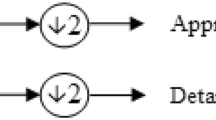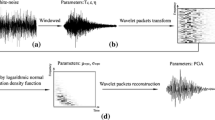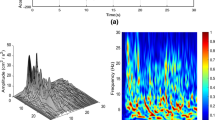Abstract
The aim of this paper is to extend a stochastic model for simulation of highly nonstationary ground motions (GMs). In this model, the dual-tree complex discrete wavelet transform (DT-CDWT) is applied to a recorded ground motion to extract its wavelet coefficients and then the Smooth Transition Generalized Autoregressive Conditional Heteroscedastic (ST-GARCH) model is used to simulate these coefficients. This model simulates nonstationary features of real GMs greatly, because the conditional variance estimated by this model changes compatibly with the amplitude nonstationary features of real GMs. Because of having asymmetric structure, this model also estimates sudden changes in the amplitude of ground motions. Some of the special capabilities of this model are the simulation of multiple increasing–decreasing cycles in the temporal amplitude of GMs, prediction of several peaks in the frequency spectrum of GMs, estimation of steps of their energy curve, and simultaneous simulation of all shocks of a GM sequence. Also, this model simulates the time–frequency energy distribution of both wide-frequency and narrow-frequency bandwidth GMs.










Similar content being viewed by others
Explore related subjects
Discover the latest articles and news from researchers in related subjects, suggested using machine learning.References
Grigoriu M (2011) To scale or not to scale seismic ground-acceleration records. J Eng Mech 137:284–293
Somerville PG, Smith NF, Graves RW, Abrahamson NA (1997) Modification of empirical strong ground motion attenuation relations to include the amplitude and duration effects of rupture directivity. Seismol Res Lett 68:199–222
Hartzell S, Guatteri M, Mai PM et al (2005) Calculation of broadband time histories of ground motion, Part II: Kinematic and dynamic modeling using theoretical Green’s functions and comparison with the 1994 Northridge earthquake. Bull Seismol Soc Am 95:614–645
Rezaeian S, Der Kiureghian A (2008) A stochastic ground motion model with separable temporal and spectral nonstationarities. Earthq Eng Struct Dyn 37:1565–1584
Graves RW, Pitarka A (2010) Broadband ground-motion simulation using a hybrid approach. Bull Seismol Soc Am 100:2095–2123
Stafford PJ, Sgobba S, Marano GC (2009) An energy-based envelope function for the stochastic simulation of earthquake accelerograms. Soil Dyn Earthq Eng 29:1123–1133
Ruiz P, Penzien J (1971) Stochastic seismic response of structures. J Eng Mech (ASCE) 97:441–456
Mobarakeh AA, Rofooei FR, Ahmadi G (2002) Simulation of earthquake records using time-varying ARMA (2,1) model. Probab Eng Mech 17:15–34
Wang L, McCullough M, Kareem A (2014) Modeling and simulation of nonstationary processes utilizing wavelet and Hilbert transforms. J Eng Mech 140:345–360
Zhang Y, Zhao F, Yang C (2015) Generation of nonstationary ground motions compatible with multidamping response spectra. Bull Seismol Soc Am 105:341–353
Zhang Y, Zhao F (2010) Artificial ground motion compatible with specified peak ground displacement and target multi-damping response spectra. Nucl Eng Des 240:2571–2578
Sabetta F, Pugliese A (1996) Estimation of response spectra and simulation of nonstationary earthquake ground motions. Bull Seismol Soc Am 86:337–352
Yeh C-H, Wen YK (1990) Modeling of nonstationary ground motion and analysis of inelastic structural response. Struct Saf 8:281–298
Papadimitriou K (1990) Stochastic characterization of strong ground motion and application to structural response. Report No. EERL 90-03, Earthquake Engineering Research Laboratory, California Institute of Technology, Pasadena, CA
Rezaeian S, Der Kiureghian A (2010) Simulation of synthetic ground motions for specified earthquake and site characteristics. Earthq Eng Struct Dyn 39:1155–1180
Rezaeian S, Der Kiureghian A (2012) Simulation of orthogonal horizontal ground motion components for specified earthquake and site characteristics. Earthq Eng Struct Dyn 41:335–353
Medel-Vera C, Ji T (2016) A stochastic ground motion accelerogram model for Northwest Europe. Soil Dyn Earthq Eng 82:170–195
Tsioulou A, Taflanidis AA, Galasso C (2018) Modification of stochastic ground motion models for matching target intensity measures. Earthq Eng Struct Dyn 47:3–24
Vetter CR, Taflanidis AA, Mavroeidis GP (2016) Tuning of stochastic ground motion models for compatibility with ground motion prediction equations. Earthq Eng Struct Dyn 45:893–912
Yamamoto Y, Baker JW (2013) Stochastic model for earthquake ground motion using wavelet packets. Bull Seismol Soc Am 103:3044–3056
Huang D, Wang G (2015) Stochastic simulation of regionalized ground motions using wavelet packets and cokriging analysis. Earthq Eng Struct Dyn 44:775–794
Hazirbaba YD, Tezcan J (2016) Image based modeling and prediction of nonstationary ground motions. Comput Struct 174:85–91
Tezcan J, Cheng J, Cheng Q (2014) Modeling and prediction of nonstationary ground motions as time–frequency images. IEEE Trans Geosci Remote Sens. https://doi.org/10.1109/TGRS.2014.2347335
Wang D, Fan Z, Hao S, Zhao D (2018) An evolutionary power spectrum model of fully nonstationary seismic ground motion. Soil Dyn Earthq Eng 105:1–10
Sharbati R, Khoshnoudian F, Ramazi HR, Amindavar HR (2018) Stochastic modeling and simulation of ground motions using complex discrete wavelet transform and Gaussian mixture model. Soil Dyn Earthq Eng 114:267–280
Sharbati R, Khoshnoudian F, Koopialipoor M, Tahir MM (2019) Applying dual-tree complex discrete wavelet transform and gamma modulating function for simulation of ground motions. Eng Comput. https://doi.org/10.1007/s00366-019-00898-8
Sharbati R, Ramazi HR, Khoshnoudian F et al (2019) Stochastic model for simulation of ground-motion sequences using kernel-based smoothed wavelet transform and Gaussian mixture distribution. J Earthq Eng. https://doi.org/10.1080/13632469.2019.1605948
Vlachos C, Papakonstantinou KG, Deodatis G (2016) A multi-modal analytical non-stationary spectral model for characterization and stochastic simulation of earthquake ground motions. Soil Dyn Earthq Eng 80:177–191
Vlachos C, Papakonstantinou KG, Deodatis G (2018) Predictive model for site specific simulation of ground motions based on earthquake scenarios. Earthq Eng Struct Dyn 47:195–218
Oruç Ö (2019) An efficient wavelet collocation method for nonlinear two-space dimensional Fisher–Kolmogorov–Petrovsky–Piscounov equation and two-space dimensional extended Fisher-Kolmogorov equation. Eng Comput. https://doi.org/10.1007/s00366-019-00734-z
Kumar KH, Vijesh VA (2019) Legendre wavelet-based iterative schemes for fourth-order elliptic equations with nonlocal boundary conditions. Eng Comput. https://doi.org/10.1007/s00366-019-00766-5
Sharbati R, Rahimi R, Koopialipoor MR et al (2020) Detection and extraction of velocity pulses of near-fault ground motions using asymmetric Gaussian chirplet model. Soil Dyn Earthq Eng 133:106123
Mallat S (2009) A wavelet tour of signal processing: the sparce way. Elsevier, Amsterdam
Zhu XX, Bamler R (2010) Tomographic SAR inversion by $ L_ 1 $-norm regularization—The compressive sensing approach. IEEE Trans Geosci Remote Sens 48:3839–3846
Beckouche S, Ma J (2014) Simultaneous dictionary learning and denoising for seismic data. Geophysics 79:A27–A31
Boßmann F, Ma J (2016) Asymmetric chirplet transform—part 2: Phase, frequency, and chirp rate asymmetric chirplet transform: part 2. Geophysics 81:V425–V439
Tao C, Pan H, Li Y, Zou Z (2015) Unsupervised spectral–spatial feature learning with stacked sparse autoencoder for hyperspectral imagery classification. IEEE Geosci Remote Sens Lett 12:2438–2442
Kuyuk HS, Yildirim E, Dogan E, Horasan G (2012) Application of k-means and Gaussian mixture model for classification of seismic activities in Istanbul. Nonlinear Process Geophys 19:411–419
Baker JW (2007) Quantitative classification of near-fault ground motions using wavelet analysis. Bull Seismol Soc Am 97:1486–1501
Kingsbury N (1999) Image processing with complex wavelets. Philos Trans R Soc London Ser A Math Phys Eng Sci 357:2543–2560
Bollerslev T (1996) Fractionally integrated generalized autoregressive conditional heteroskedasticity. J Econ 74:3–30
Engle RF (1982) Autoregressive conditional heteroscedasticity with estimates of the variance of United Kingdom inflation. Econ J Econ Soc 50:987–1007
González-Rivera G (1998) Smooth-transition GARCH models. Stud Nonlinear Dyn Econ 3:61–78
Lubrano M (2001) Smooth transition GARCH models: a Bayesian perspective. Rech Econ Louvain 67:257–287
Haas M, Krause J, Paolella MS, Steude SC (2013) Time-varying mixture GARCH models and asymmetric volatility. N Am J Econ Financ 26:602–623
Medeiros MC, Veiga A (2009) Modeling multiple regimes in financial volatility with a flexible coefficient GARCH (1, 1) model. Econ Theory 25:117–161
Boashash B, Khan NA, Ben-Jabeur T (2015) Time–frequency features for pattern recognition using high-resolution TFDs: A tutorial review. Dig Signal Process 40:1–30
PEER P (2014) Ground motion database. https://peer.berkeley.edu/peer_ground_motion_database. Accessed 26 Mar 2014.
Conte JP, Peng BF (1997) Fully nonstationary analytical earthquake ground-motion model. J Eng Mech 123:15–24
Author information
Authors and Affiliations
Corresponding author
Additional information
Publisher's Note
Springer Nature remains neutral with regard to jurisdictional claims in published maps and institutional affiliations.
Rights and permissions
About this article
Cite this article
Sharbati, R., Ramazi, H., Khoshnoudian, F. et al. The smooth transition GARCH model for simulation of highly nonstationary earthquake ground motions. Engineering with Computers 38, 1529–1541 (2022). https://doi.org/10.1007/s00366-020-01117-5
Received:
Accepted:
Published:
Issue Date:
DOI: https://doi.org/10.1007/s00366-020-01117-5




